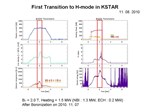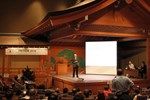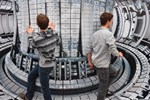The superconducting wires that ensure continuous circulation of the high intensity electrical current necessary for operation are one of the key systems of the ITER Tokamak.
The manufacturing of this system will be performed by six of the seven ITER Members. The approaches, methods and techniques may be different in each of these countries, but if we ask a competent professional to define the role of superconductor technology in the future installation, the answer will be the same everywhere: the superconductor is a system of vital importance for ITER—it is the blood in the vascular system of this giant machine.
Requirements for the manufacturing of superconductors are therefore particularly strict. And the cable itself is a work of technical art.
Superconductors destined for ITER are a unique cable product containing more than ten thousand very thin filaments, usually not more than 2 to 6 microns thick. The human hair, in comparison, is about 40 to 110 microns.
Manufacturing includes a succession of delicate operations that require both "Swiss accuracy" and "Russian ingenuity." Patience is an equally important parameter: it takes approximately nine months to transform raw materials into the final product.
Back in Soviet times, when every Republic participated in the process for the sake of the common purpose, the manufacturing of superconductors was concentrated in Kazakhstan. Now, it has become necessary for Russia to develop its own manufacturing industry.
The ground for this industry was laid at the "Chupcha Meckanickaya Zavod," the Chepetsky Mechanical Plant located in the city of Glazov some 1,000 km east of Moscow. There, Workshop #87 has developed into a real "Superconductor Mecca" equipped with vast production space, modern giant rolling mills and roaring machines. All this in a strikingly clean and immaculate environment. So much for the stereotype of decaying domestic production facilities with peeling plaster and pre-Revolution machinery ...
Development of the Chepetsky Mechanical Plant began in 2004. Considerable work was accomplished to dismantle and replace the old foundation, to modernize and adjust the equipment, and to standardize production processes. In order to prepare for the manufacturing of superconducting materials for ITER, the plant purchased more than one hundred tools and components. All this was done within a very short time, as two pilot batches (500 kg of niobium-tin strand, and 100 kg of niobium-titanium strand) were due for delivery at the end of 2007.
The deadline was met, the task fulfilled, and on 23 April 2009 the facility was officially commissionned and qualified to manufacture the superconducting material for the world's largest fusion device.
Along with the facility, the staff itself grew too. In 2004 there were only a few truly qualified specialists in the area of superconductivity at the workshop. Today, one can see scores of young people wearing uniforms that bear "ChMZ" and "ITER" logos. When asked whether they'd prefer to work and live in Moscow, their answer is unanimous: "We prefer to work at our own plant."
The head of this production facility is a young man named Denis Anishuk. A graduate of Yekaterinburg University, Anishuk began his career at Chepetsky as an assistant foreman. Five years later, he became a technologist for the chemical-metallurgical workshop, and in two more years he was appointed head of the new superconductor manufacturing workshop.
Anishuk said he was proud to have gathered a team of highly qualified professionals capable of independently solving any issue related to the production. "As we proceed," he says, "we improve our skills and gain new experience. Along with modern equipment and advanced technologies, this is a key factor in fullfilling our task."
Being one of the key contributors to the ITER Project, good salaries and social conditions were arranged, boundary conditions facilitated the recruitment of high quality personnel. All of these factors contributed to making the Chepetsky production facility competitive on the world market.
On Wednesday, 17 November, the ITER Headquarters' First Stone will be laid by Academician Velikhov and Prof. Motojima, in the presence of all the Heads of Delegation to the ITER Council.
On the platform overlooking the future Headquarters worksite, the stone—quite a large chunk of rock actually—is being prepared by Marseille sculptor Bernard Brandi and stone carvers from Entreprise Pilati, also from Marseille.
The 2.5-tonne rock, which comes from the depths of the Tokamak Pit, will be placed in the entrance hall, or in the nearby gardens of the future building, bearing witness to that day in mid-November 2010 when the first of the ITER buildings symbolically came into existence.
Bernard Brandi, who specializes in creating public monuments, has created a strange and futuristic work of art that carries the symbols of what ITER is about. Of course we will say no more, so that the unveiling of the First Stone, on Wednesday, comes as a surprise to everyone.
"I tried to do something dynamic," says the artist. "I used different materials in order to create something that conveys the significance of the project and is a bit unsettling at the same time."
We will know on Wednesday if the artist has succeeded in capturing in stone the "spirit of ITER."
Considering that some 34 nations are represented in ITER; and further considering that each nation can be broken into cultural or ethnic subcategories (as this poster in Building 525 A suggests), the "Comparative Culture Workshop" cycle could take some time to complete.
This new endeavour in cultural understanding succeeds the "Intercultural Seminars" that were organized in 2008-2009. "We felt a need to be more interactive," explains Agence Iter France's Shawn Simpson, "and to focus on the work interaction between people of different cultures."
Participants in Shawn's workshop have already gone through the challenges and benefits of "working with" the Americans, the French (there are requests to do that one again), the Japanese and most of the Europeans. The Spaniards will be next in December.
"I'm very pleasantly surprised by the number of people who show up despite the pressure of work and deadlines," says Shawn. The workshop doesn't "teach" nor does it provide quick-fix answers—it helps to open the mind. "What is particularly satisfying is when I hear someone say: 'Oh, I understand why so and so didn't answer my mail right away!' Or: 'Now, that explains why that meeting with X... went so badly...'"
Have three years of intercultural pedagogy been efficient? "Definitely!" says Shawn. "Intercultural awareness at ITER is getting better every year ..."
|
They come from every walk of science and technology. Some of them design large plants while others manufacture small equipment, work in defence labs, astrophysics research centres, health or environmental agencies ...
Whatever the nature of their work, they share a common interest in a light and elusive element: tritium. They are the members of the "worldwide tritium community," eager to learn, confront their experience and address the various challenges they are faced with.
The tritium community gathers every three years for a three-day conference, usually "close to where the action is," like they did in Rochester, N.Y. (US) in 2007, or in Baden-Baden, near Karlsruhe, Germany, in 2004.
From 24 to 29 October this year, the community met in Nara, Japan. No tritium lab or CANDU plant nearby, but, for a change, one of the largest concentration of World Heritage Sites and National Treasures—the city was the imperial capital of Japan in the 8th century and has retained the best part of its architectural wonders.
"You learn a lot during these gatherings," says Manfred Glugla, ITER Fuel Cycle Engineering Division Head, who was part of the nine-member-strong ITER delegation to the conference. "You get opportunities to talk to people who look at problems from a different perspective, and you come back with new criteria, a new way of looking at this detail in this component ..."
At Nara, ITER was placed centre stage. Presentations on the deuterium-tritium fuel cycle process system by Manfred Glugla; on the safety approach on tritium-related issues, also by Glugla on behalf of Deputy Director-General Carlos Alejaldre who couldn't make the trip; on hot cell cleaning and decontamination methods by Section Leader Magali Benchikhoune, opened the five-day conference.
"The talks were well received and the participants were very keen to learn about our project," reflects Glugla. "In discussions, a very interesting issue was brought up. How will we make sure that we preserve and continue to develop the knowledge we accumulated in the R&D period through the present design and construction phases all the way to the system testing and tritium commissioning of ITER, all of which will take place several years from now? How do we bridge this gap?"
The issue is a crucial one and Manfred Glugla and his ITER colleagues are convinced that the answer lies in pursuing high-level university research, training a new generation of "knowledgeable people" and attracting them to projects that involve tritium handling—and particularly to ITER.
This is something the tritium community could discuss at greater length at the next conference in 2013, which could be held "somewhere in southern France"—maybe in Nice, or, even better, in Aix which combines proximity "to the action" and significant historical heritage.
Belgium is currently assuming the EU presidency. In this context, an academic session and an exhibition were organized to draw the attention of the broader public to fusion and fusion research, and in particular to explain the need for the next-step ITER device: The academic session "Fusion, a compelling energy source & ITER, the crucial step towards creating a sun on earth" was organized on 24 September.
EFDA's Fusion Expo (presently under the responsibility of the Slovenian Fusion Association) is visiting Brussels from 25 October to 15 November. Both events are co-organized by the Belgian EURATOM Association, the European Commission, Directorate Euratom of DG RTD and ITER-Belgium at the Palace of the Academies, next to the Royal Place in the heart of Brussels.
The event brought together people from the academic and political world, and attracted industrial partners interested or involved in ITER. After an opening word by Prof. Weynants of the Belgian EURATOM Association, Mr. Cerexhe (who presides the EU Competitiveness Council for Research) stressed the need for international collaboration on this important project.
Mr. Smits, the recently appointed Director General of the DG Research of the European Commission, placed ITER in the context of the current and future Framework Programmes and underlined the willingness to support this endeavor.
Prof. Motojima, the Director-General of the ITER Organization, presented ITER as an opportunity and a reality, "the project now having gone beyond the stage of being a mere dream." Director of Agence Iter France Jérôme Pamela explained the timeline of ITER and the important role of Europe in the realization and success of this machine.
Prof. Niek Lopes-Cardozo (teaching the science and technology of nuclear fusion at TU-Eindhoven, the Netherlands) talked about the various physics and technological challenges fusion research is facing on its way to constructing fusion-driven power stations, highlighting fairly opaque topics such as anomalous transport in his usual lighthearted and dynamical style by drawing a parallel between controlling plasmas in fusion devices and ... preparing a cup of cappuccino!
After the talks, a number of movies were presented to the audience. First, a short movie in which the Fusion Expo was presented was revealed to the audience to give them a flavour of what the exhibition had to offer. The audience also had the opportunity to view the new 3D interactive movie of the European Commission. This "3D Fusion Show" aims to present fusion in an entertaining way, and is on display at the Fusion Expo. A little girl named Fusia is your mentor and guide.
The academic session was honored by the presence of Prince Philippe of Belgium who showed a lot of interest and posed many questions during the walking dinner that followed the lectures.
The Brussels edition of the Fusion Expo opened its doors on 25 October in the presence of Dirk Frimout, who joined the second 1992 Atlantis space shuttle mission and hereby became the first Belgian astronaut. The exhibition will stay open for the public until 15 November. Information can be found on the web site www.iterbelgium.be where it is also possible to download the poster of the exhibition and the movie presenting it.
There are some 1.5 million employees at the State Grid Corporation of China (SGCC), 25 of whom were welcomed at ITER last Monday, 8 November.
The visiting party, which also included members of Schneider Electric China, was headed by Yang Qing, one of the corporation's six executive vice presidents.
SGCC is the largest utility in the world. This should come as no surprise, as it serves the better part of the country's 1.3 billion inhabitants.
Over the past four years, SGCC has been engaged in a project called "Power for All" that aims to connect several million families in the poorest and most remote areas of the country to the national grid.
China's present electricity production is based essentially (76 percent) on coal. Nuclear energy accounts for a mere 1 percent—less than renewable sources like wind or solar energy (1.5 percent).
Such a heavy dependence on a fossil fuel "is not satisfying" acknowledges Yang Qing. "We intend to add 70 MW to our present 10 MW nuclear capacity in the coming decade. It is clear," he adds, "that in order to meet the growing national demand we must develop new energy sources."
Yang Qing is convinced that fusion could be one of them. "We know that commercial fusion is quite a long-term perspective. But it is strategic, not only for us but for the whole of mankind."
|








